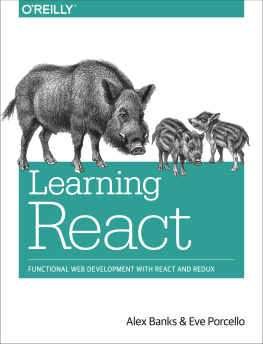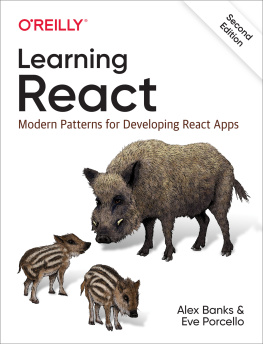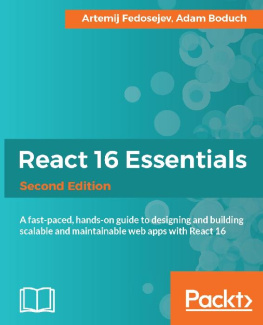Alves - Learning React js: Learn React JS From Scratch with Hands-On Projects , 2nd Edition
Here you can read online Alves - Learning React js: Learn React JS From Scratch with Hands-On Projects , 2nd Edition full text of the book (entire story) in english for free. Download pdf and epub, get meaning, cover and reviews about this ebook. year: 2020, genre: Computer. Description of the work, (preface) as well as reviews are available. Best literature library LitArk.com created for fans of good reading and offers a wide selection of genres:
Romance novel
Science fiction
Adventure
Detective
Science
History
Home and family
Prose
Art
Politics
Computer
Non-fiction
Religion
Business
Children
Humor
Choose a favorite category and find really read worthwhile books. Enjoy immersion in the world of imagination, feel the emotions of the characters or learn something new for yourself, make an fascinating discovery.

Learning React js: Learn React JS From Scratch with Hands-On Projects , 2nd Edition: summary, description and annotation
We offer to read an annotation, description, summary or preface (depends on what the author of the book "Learning React js: Learn React JS From Scratch with Hands-On Projects , 2nd Edition" wrote himself). If you haven't found the necessary information about the book — write in the comments, we will try to find it.
Alves: author's other books
Who wrote Learning React js: Learn React JS From Scratch with Hands-On Projects , 2nd Edition? Find out the surname, the name of the author of the book and a list of all author's works by series.
Learning React js: Learn React JS From Scratch with Hands-On Projects , 2nd Edition — read online for free the complete book (whole text) full work
Below is the text of the book, divided by pages. System saving the place of the last page read, allows you to conveniently read the book "Learning React js: Learn React JS From Scratch with Hands-On Projects , 2nd Edition" online for free, without having to search again every time where you left off. Put a bookmark, and you can go to the page where you finished reading at any time.
Font size:
Interval:
Bookmark:
Learning React js
Learn React JS From Scratch with Hands-On Projects
nd Edition
2020
By Claudia Alves
For information contact :
(alabamamond@gmail.com, memlnc)
http://www.memlnc.com
nd Edition: 2020
Learning React js
Copyright 2020 by Claudia Alves
" Programming isn't about what you know; it's about what you can figure out . - Chris Pine
Before you begin, please note that this is a beginner-friendly guide that covers the concepts I classify as fundamentals for working with React. It is not a complete guide to React but rather a complete introduction.
At the end of this guide, I list a few next-level resources for you. This guide will pave the way for you to understand them.
Memlnc.com
Content
- WHAT IS REACT?
- VIRTUAL DOM PERFORMANCE
- TERMINOLOGY IN REACT
- SINGLE-PAGE APP
- BANKS
- BUNDLERS
- PACKAGE MANAGER
- CONTENT DISTRIBUTION NETWORK
- ELEMENTS
- THE INGREDIENTS
- CHARACTERISTICS
- PROPS.CHILDREN
- CASE
- LIFE CYCLE DEPENDENCIES
- ADJUSTED AND UNCONFIGURED COMPONENTS
- KEYS
- REFERENCES
- EVENTS
- MATCHING
- Introduction
- From the author
- Connect react as a script
- Component creation
- Using props
- If-else, ternary operator
- Let's refactor ...
- Prop-types
- Using state
- More about state
- Working with input
- Component life cycle
- Working with a form
- Add news
- Summary by Basics
- create-react-app
- Tidying and imports
- Asynchronous requests
- Spam filter
- componentWillReceiveProps
- getDerivedStateFromProps
- Let's refactor ...
Conclusion
Facebook's React has changed the way we think about web applications and user interface development. Due to its design, you can use it beyond web. A feature known as the Virtual DOM enables this.
In this chapter we'll go through some of the basic ideas behind the library so you understand React a little better before moving on.
React is a JavaScript library that forces you to think in terms of components. This model of thinking fits user interfaces well. Depending on your background it might feel alien at first. You will have to think very carefully about the concept of state and where it belongs.
Because state management is a difficult problem, a variety of solutions have appeared. In this book, we'll start by managing state ourselves and then push it to a Flux implementation known as Alt. There are also implementations available for several other alternatives, such as Redux, MobX, and Cerebral.
React is pragmatic in the sense that it contains a set of escape hatches. If the React model doesn't work for you, it is still possible to revert back to something lower level. For instance, there are hooks that can be used to wrap older logic that relies on the DOM. This breaks the abstraction and ties your code to a specific environment, but sometimes that's the pragmatic thing to do.
One of the fundamental problems of programming is how to deal with state. Suppose you are developing a user interface and want to show the same data in multiple places. How do you make sure the data is consistent?
Historically we have mixed the concerns of the DOM and state and tried to manage it there. React solves this problem in a different way. It introduced the concept of the Virtual DOM to the masses.
Virtual DOM exists on top of the actual DOM, or some other render target. It solves the state manipulation problem in its own way. Whenever changes are made to it, it figures out the best way to batch the changes to the underlying DOM structure. It is able to propagate changes across its virtual tree as in the image above.
Handling the DOM manipulation this way can lead to increased performance. Manipulating the DOM by hand tends to be inefficient and is hard to optimize. By leaving the problem of DOM manipulation to a good implementation, you can save a lot of time and effort.
React allows you to tune performance further by implementing hooks to adjust the way the virtual tree is updated. Though this is often an optional step.
The biggest cost of Virtual DOM is that the implementation makes React quite big. You can expect the bundle sizes of small applications to be around 150-200 kB minified, React included. gzipping will help, but it's still big.
React facilitates the creation of interactive user interfaces. Just design views for each status in your app, and React will efficiently update and synthesize the right components when your data changes.
React relies primarily on the concept of components. You have to build packaged components that manage their own state, and then install these components together to create complex user interfaces. Since component logic is written using JavaScript instead of template mode, you can easily pass a lot of data through your application and keep the state away from DOM.
React is based on the principle of learning once and writing anywhere. You don't assume you are dealing with a specific technology, but you can develop new features without rewriting a new code. React can be rendered on the server using Node.js, and mobile applications can be created via React Native.
Single-page Application is an application that loads a single HTML page and all the necessary extensions (such as CSS and JavaScript) required for the application to work. No interactions with the page or subsequent pages require a return to the server again, which means that the page is not reloaded.
Although you can build a single-page application in React, it is not necessary. React can also be used to optimize small portions of the site with greater interactivity. A code written using React can co-exist with the format on the server using PHP or any other server-side libraries. In fact, this is exactly how to use React on Facebook.
ES6, ES2015, ES2016, etc ..
These abbreviations refer to the latest versions of the ECMAScript standard, for which JavaScript is implemented. ES6 (also called ES2015) includes many additions to earlier versions such as arrow functions, classes, literal templates, and let and const statements. You can learn more about the specific versions here.
The JavaScript sink takes JavaScript code, converts it, and returns JavaScript in another format. The most common use case is to take the ES6 wording and convert it to an older wording so that older browsers can interpret it. The most frequently used banker with React is Babel.
Packers take CSS and JavaScript code written as separate modules (usually hundreds), and group them together in a few performance-optimized files for browsers. One of the most commonly used packages in React applications is Webpack and Browserify.
Package Manager is a tool that allows you to manage the credits in your project. The two most commonly used packet managers in React are npm and Yarn, both of which are the interface of the same npm packet recorder.
CDN stands for Content Delivery Network. These networks distribute static and cached content from a network of servers around the world.
JSX
JSX is an extended formatting to JavaScript, which is similar to template language but has the full power of JavaScript. JSX behaves into calls to the React.createElement () function, which returns abstract JavaScript objects called React elements. For an introduction to JSX see here, and for more detailed information about JSX see here.
Next pageFont size:
Interval:
Bookmark:
Similar books «Learning React js: Learn React JS From Scratch with Hands-On Projects , 2nd Edition»
Look at similar books to Learning React js: Learn React JS From Scratch with Hands-On Projects , 2nd Edition. We have selected literature similar in name and meaning in the hope of providing readers with more options to find new, interesting, not yet read works.
Discussion, reviews of the book Learning React js: Learn React JS From Scratch with Hands-On Projects , 2nd Edition and just readers' own opinions. Leave your comments, write what you think about the work, its meaning or the main characters. Specify what exactly you liked and what you didn't like, and why you think so.








